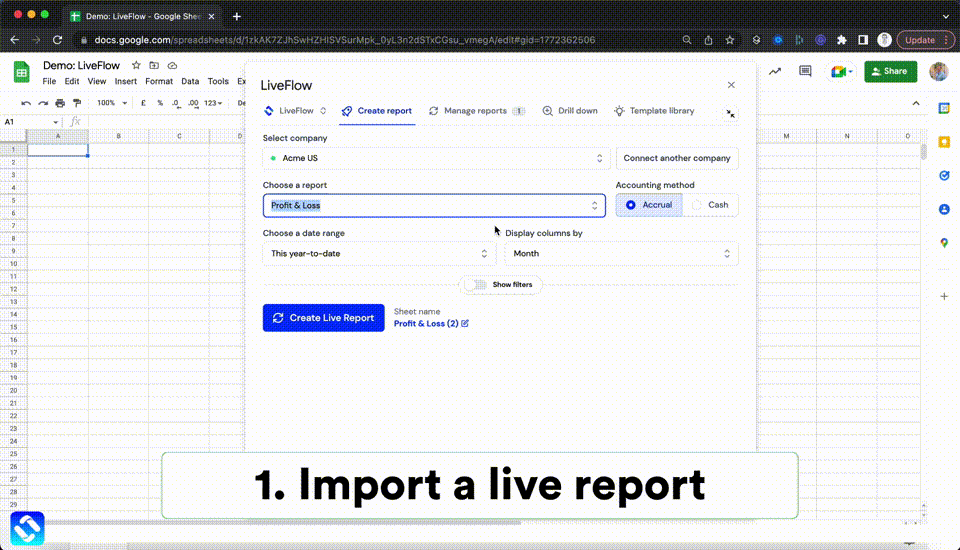This is a Guest Blog post by LiveFlow's customer Michael Alliman
About Alliman Business Group
This is how we’ve scaled LiveFlow to all (70+) of our clients. I’m going to cover just that, but first just a bit of background: We are a 4 year old bookkeeping firm Alliman Business Group focusing exclusively on a subset of a niche market. That’s only important because we have a unique chart of accounts, but it’s the same COA for all of our clients, meaning all of our reports are built off the same essential inputs.
We are also systems-driven and have invested a lot of time (and money) into finding or developing tools to make us increasingly efficient. We currently have over 70 monthly bookkeeping clients, and two employees including me, so our ability to take on new clients is largely based on creating time in our schedules for new business. And just to make it a bit more complicated, we are 100% virtual, with clients across the US, and my partner lives on the east coast (I’m in California).
Tools for clients
With that as background, we create (and use) a series of reports in LiveFlow for each client because of the time-capacity LiveFlow creates.
We use Google Drive exclusively for our folders and files. Each client has their own folder which contains a series of sub-folders that looks something like this:

In the 2022 folder you’d find something like this:

And in the LiveFlow Reports folder you’d find this:

And this is where the magic happens! Inside the LiveFlow(LF) Financial Folder I’ve built out all of the financial reports that my client needs AND several reports that we use for analytics.
How we use LiveFlow
We create one LiveFlow report that captures the uncategorized items on a Year-to-date basis (AMA/CTBS - 2022) Between the 3rd and 5th of each month we make copies of these reports (this is important) and put the copy into the month we are closing. We then modify the worksheets slightly (adding columns for comments) and then share them with each client for their responses.
Before LiveFlow, this required us to log into each client’s QB accounts, download detailed reports of each uncategorized account (income/expense), modify the worksheet, then share it with the client. That’s a creepy nightmare!
Since the LiveFlow report is set to pull the Year-to-Date information, we now just make a copy and share from the reports that have already been created. Time saved? 350 minutes per month, or almost six hours per month (which is enough time for two small clients, or one large client). Yikes!
The other LiveFlow deck we create is “LiveFlow Financials” is the financial statements which includes - at a minimum:
- P&L for Month
- P&L YTD
- P&L YTD by Month
- P&L YTD Year-over-Year
- Balance Sheet
When we first started using LiveFlow, we created each of these reports one at a time for each client. It was tedious, but worth it. Now each client has a full set of reports that they can access at any time. It’s a powerhouse for our back-end.
We’ve also started building out dashboards in the same file with the intention of having the shared LiveFlow folder be the location our clients go to review their financials. This is a simple example of what we now provide to clients (one of many dashboards):
The financial data on the left is from a template LiveFlow provides. The graphical data on the right is done with some simple lookup functions, for the most part. The important thing, though, is I can copy this sheet, “attach” it to the LiveFlow financials worksheet, and then just connect it to the database report for the new client.
Now that the LiveFlow team has given us the ability to use a set of reports as a template for a new client, I just copy the worksheet with all the tabs (reports) we use daily to the new client, connect their QB account to LiveFlow, and “update” all the reports with the new client’s data. Here’s how. This includes all the dashboard data as well. It’s just so easy now. Thanks LiveFlow!
We can literally set up a client (with all the reports they will need for as long as they are a client) one time, and we’re finished. Start to finish is less than ½ hour, and we build that time into our initial proposal. Life with LiveFlow is so great.
Cheers.
Michael Alliman














